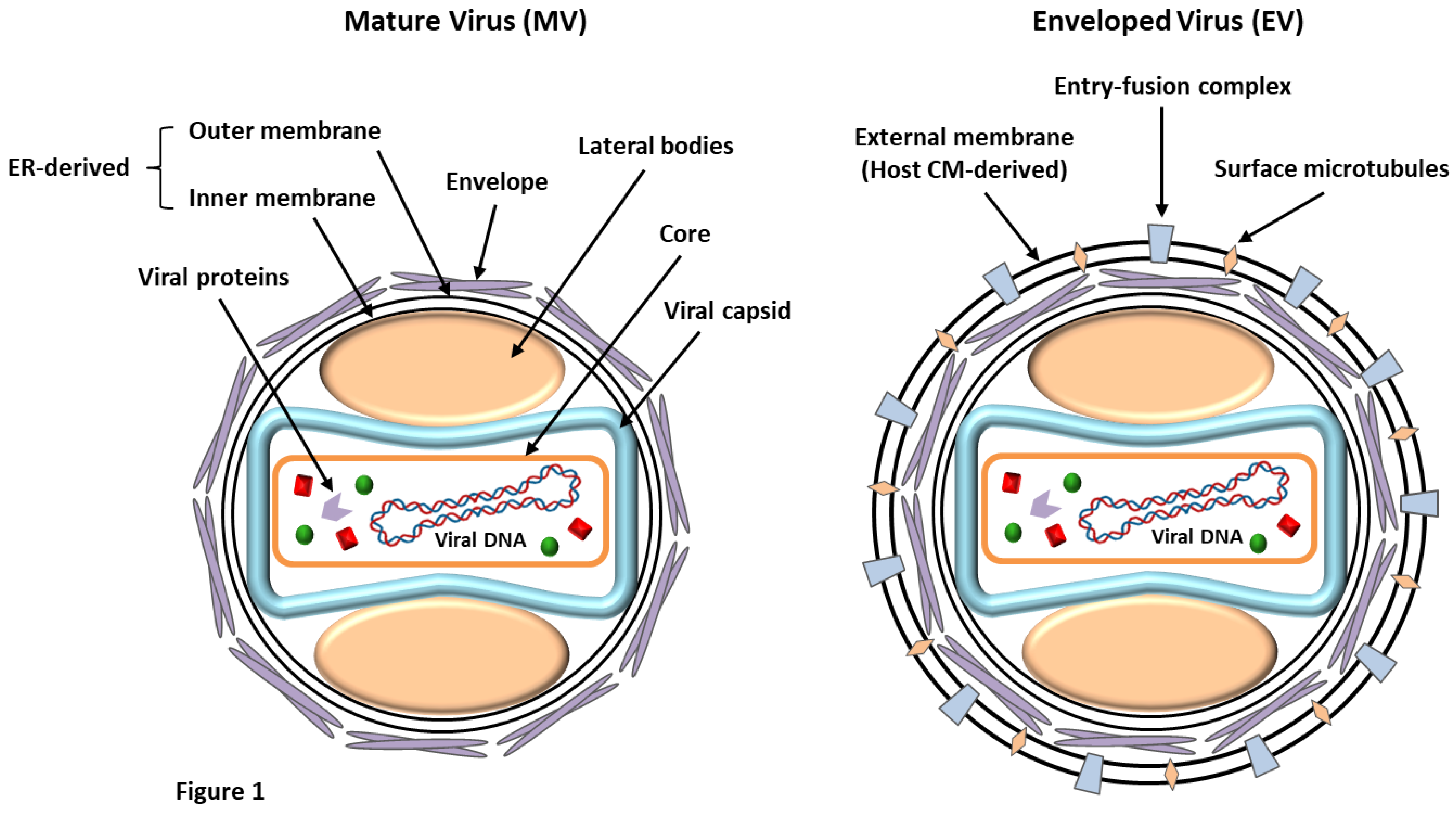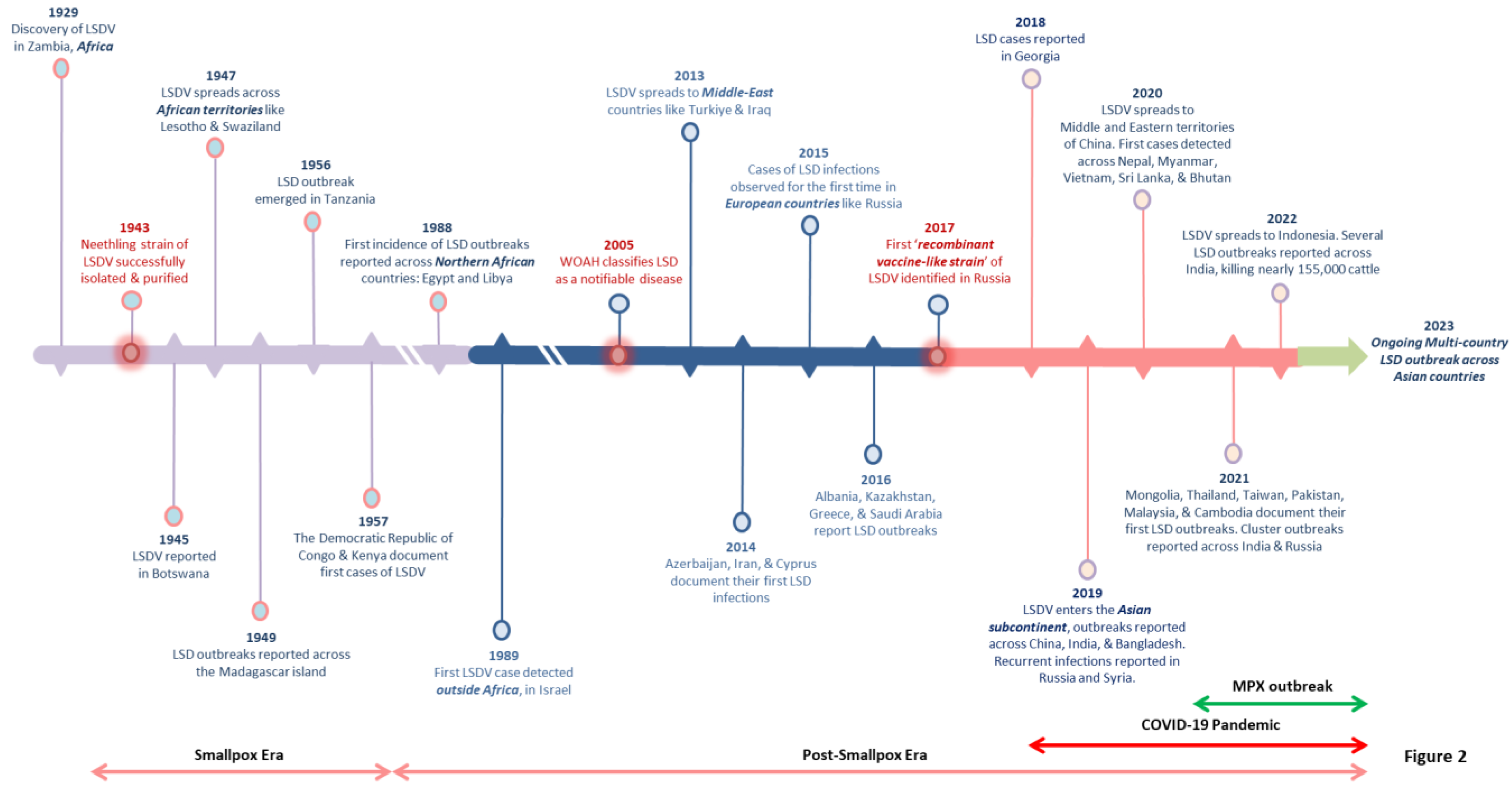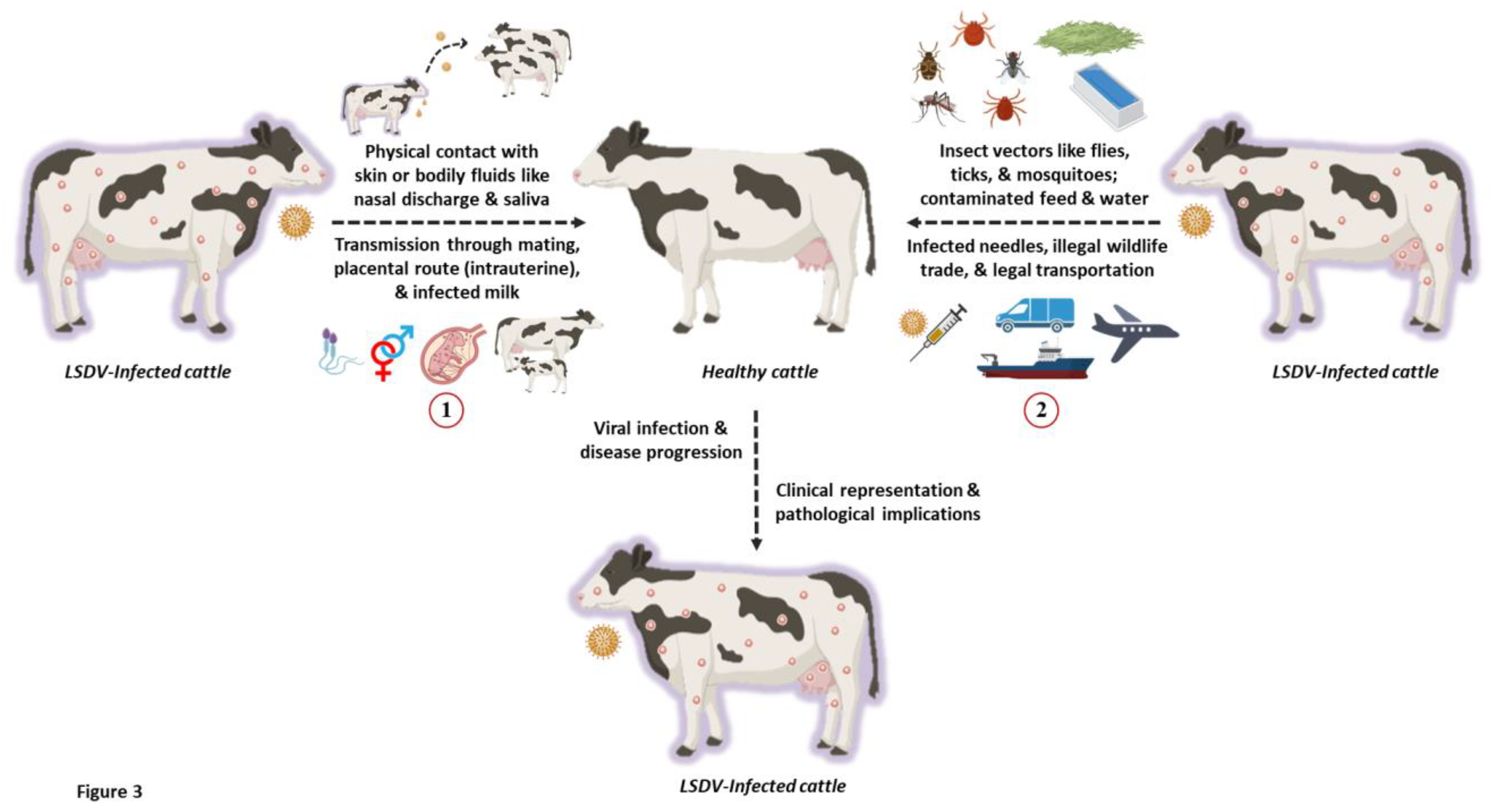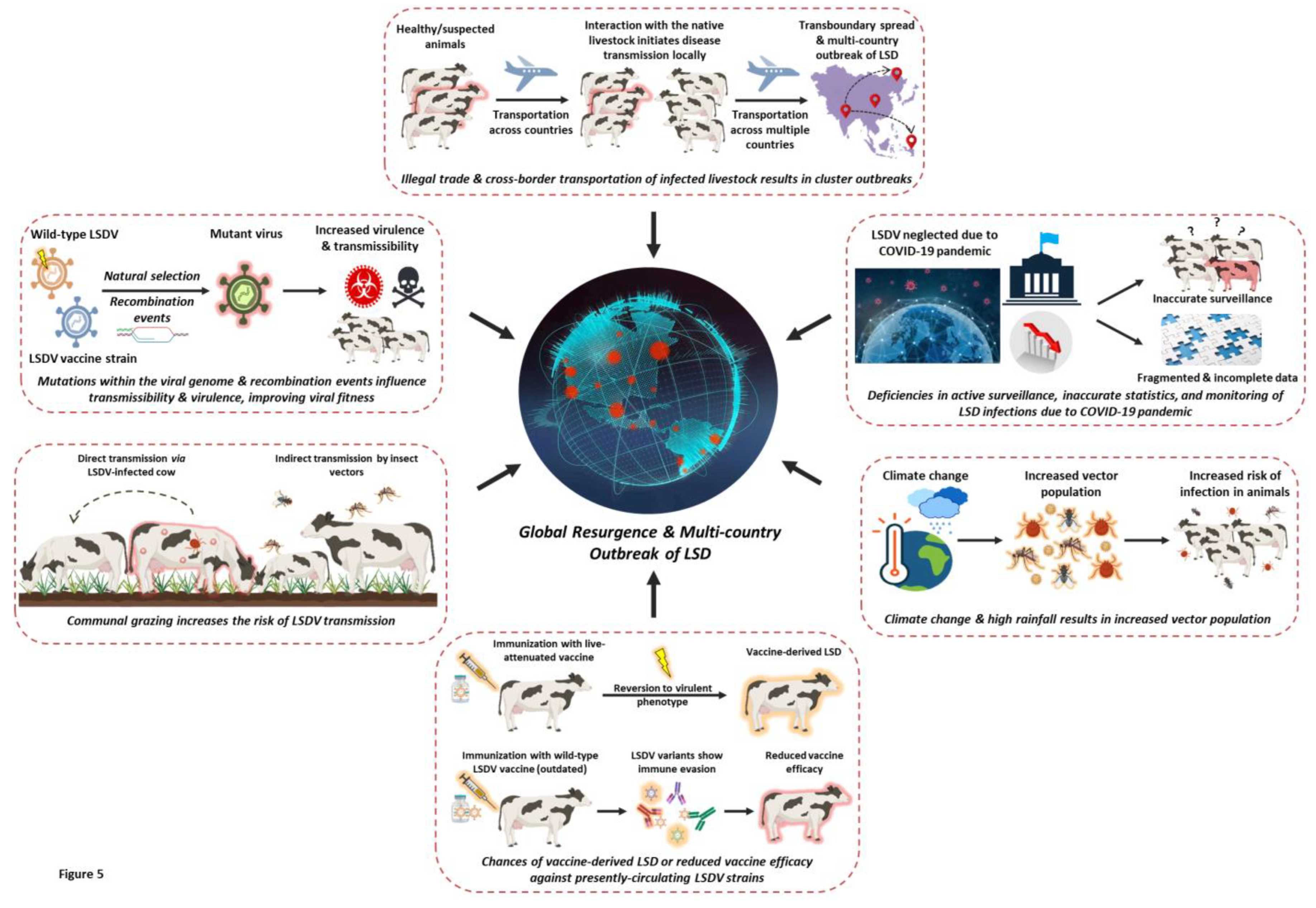Submitted:
05 February 2023
Posted:
06 February 2023
Read the latest preprint version here
Abstract
Keywords:
1. Introduction
2. Etiology of LSDV: a brief overview of virus structure
3. Epidemiological trends and the expanding geographical footprint of LSD: unraveling the viral transition
4. Transmission, reservoirs, and hosts of LSDV: a panoramic yet distal view
5. Pathogenesis and clinical representations of LSDV: from signs to symptoms
6. Diagnosis, preventive measures, and treatment of LSD
7. Current scenario & economic repercussions of LSD outbreaks
8. Causes of LSDV resurgence: from ground reality to speculations, and beyond
Conclusions
Funding
Data availability
Competing Interest
Acknowledgments
Abbreviations
References
- Mourya D, Yadav P, Ullas PT, et al. Emerging/re-emerging viral diseases & new viruses on the Indian horizon. Indian Journal of Medical Research 2019, 149, 447-467. [CrossRef]
- Chadha J, Khullar L, Gulati P, et al. Insights into the monkeypox virus: Making of another pandemic within the pandemic? Environmental Microbiology 2022, 24, 4547–4560. [Google Scholar] [CrossRef]
- Tuppurainen ESM, Venter EH, Shisler JL, et al. Review: Capripoxvirus Diseases: Current Status and Opportunities for Control. Transboundary and Emerging Diseases 2017, 64, 729-745. [CrossRef]
- Khan YR, Ali A, Hussain K, et al. A review: Surveillance of lumpy skin disease (LSD) a growing problem in Asia. Microbial Pathogenesis 2021, 158: 105050. [CrossRef]
- Diallo A, Viljoen GJ. Genus Capripoxvirus. In: Mercer, A.A., Schmidt, A., Weber, O. (eds) Poxviruses. Birkhäuser Advances in Infectious Diseases. Birkhäuser Basel 2007, 167-181. [CrossRef]
- Gupta T, Patial V, Bali D, et al. A review: Lumpy skin disease and its emergence in India. Veterinary Research Communications 2020, 44(3-4): 111-118. [CrossRef]
- Tuppurainen ESM, Stoltsz WH, Troskie M, et al. Potential Role for Ixodid (Hard) Tick Vectors in the Transmission of Lumpy Skin Disease Virus in Cattle. Transboundary and Emerging Diseases 2011, 58, 93-104. [CrossRef]
- Liang Z, Yao K, Wang S, et al. Understanding the research advances on lumpy skin disease: A comprehensive literature review of experimental evidence. Frontiers in Microbiology 2022, 13: 1065894. [CrossRef]
- Namazi F, Khodakaram-Tafti A. Lumpy skin disease, an emerging transboundary viral disease: A review. Veterinary Medicine and Science 2021, 7, 888-896. [CrossRef]
- Selim A, Manaa E, Khater H. Molecular characterization and phylogenetic analysis of lumpy skin disease in Egypt. Comparative Immunology, Microbiology and Infectious Diseases 2021, 79, 101699. [CrossRef]
- Ayelet G, Haftu R, Jemberie S, et al. Lumpy skin disease in cattle in central Ethiopia: outbreak investigation and isolation and molecular detection of the virus. Revue Scientifique et Technique de l'OIE 2014, 33, 877-887. [CrossRef]
- Anwar A, Na-Lampang K, Preyavichyapugdee N, et al. Lumpy Skin Disease Outbreaks in Africa, Europe, and Asia (2005–2022): Multiple Change Point Analysis and Time Series Forecast. Viruses 2022, 14, 2203. [CrossRef]
- Scientific Opinion on lumpy skin disease: EFSA Panel on Animal Health and Welfare (AHAW) EFSA Journal 2015, 13, 3986. [CrossRef]
- Bhanuprakash V, Hosamani, M, Singh RK. Prospects of control and eradication of capripox from the Indian subcontinent: A perspective. Antiviral Research 2011, 91, 225-232. [CrossRef]
- Tulman ER, Afonso CL, Lu Z, et al. The Genomes of Sheeppox and Goatpox Viruses. Journal of Virology 2002, 76, 6054–6061. [Google Scholar] [CrossRef]
- Tulman ER, Afonso CL, Lu Z, et al. Genome of Lumpy Skin Disease Virus. Journal of Virology 2001, 75, 7122–7130. [Google Scholar] [CrossRef]
- Azeem S, Sharma B, Shabir S, et al. Lumpy skin disease is expanding its geographic range: A challenge for Asian livestock management and food security. The Veterinary Journal 2022, 279: 105785. [CrossRef]
- Ali AA, Esmat M, Attia H, et al. Clinical and pathological studies on lumpy skin disease in Egypt. Vet Rec 1990, 127, 549–50. [Google Scholar]
- Yeruham I, Nir O, Braverman Y, et al. Spread of lumpy skin disease in Israeli dairy herds. Veterinary Record 1995, 137, 91–93. [Google Scholar] [CrossRef] [PubMed]
- Lojkić I, Šimić I, Krešić N, et al. Complete Genome Sequence of a Lumpy Skin Disease Virus Strain Isolated from the Skin of a Vaccinated Animal. Genome Announcements 2018, 6, e00482-18. [Google Scholar] [CrossRef]
- Byadovskaya O, Prutnikov P, Shalina K, et al. The changing epidemiology of lumpy skin disease in Russia since the first introduction from 2015 to 2020. Transboundary and Emerging Diseases 2022, 69, e2551–e2562. [Google Scholar] [CrossRef]
- Das M, Chowdhury M, Akter S, et al. An updated review on lumpy skin disease: a perspective of Southeast Asian countries. Journal of Advanced Biotechnology and Experimental Therapeutics 2021, 4, 322-333. [CrossRef]
- Lu G, Xie J, Luo J, et al. Lumpy skin disease outbreaks in China, since 3 August 2019. Transboundary and Emerging Diseases 2020, 68, 216-219. [CrossRef]
- Sudhakar SB, Mishra N, Kalaiyarasu S, et al. Lumpy skin disease (LSD) outbreaks in cattle in Odisha state, India in August 2019: Epidemiological features and molecular studies. Transboundary and Emerging Diseases 2020, 67, 2408-2422. [CrossRef]
- Koirala P, Meki IK, Maharjan M, et al. Molecular Characterization of the 2020 Outbreak of Lumpy Skin Disease in Nepal. Microorganisms 2022, 10, 539. [Google Scholar] [CrossRef]
- Kumar N, Tripathi BN. A serious skin virus epidemic sweeping through the Indian subcontinent is a threat to the livelihood of farmers. Virulence 2022, 13, 1943–1944. [Google Scholar] [CrossRef] [PubMed]
- Sprygin A, Pestova Y, Wallace DB, et al. Transmission of lumpy skin disease virus: A short review. Virus Research 2019, 269: 197637. [CrossRef]
- Rouby S, Aboulsoud E. Evidence of intrauterine transmission of lumpy skin disease virus. The Veterinary Journal 2016, 209: 193-195. [CrossRef]
- Annandale CH, Holm DE, Ebersohn K, et al. Seminal Transmission of Lumpy Skin Disease Virus in Heifers. Transboundary and Emerging Diseases 2014, 61, 443–448. [Google Scholar] [CrossRef]
- Melcher U, Sprygin A, Babin Y, et al. Analysis and insights into recombination signals in lumpy skin disease virus recovered in the field. Plos One 2018, 13, e0207480. [Google Scholar] [CrossRef]
- Chihota CM, Rennie LF, Kitching RP, et al. Attempted mechanical transmission of lumpy skin disease virus by biting insects. Medical and Veterinary Entomology 2003, 17, 294–300. [Google Scholar] [CrossRef]
- El-Ansary RE, El-Dabae WH, Bream AS, et al. Isolation and molecular characterization of lumpy skin disease virus from hard ticks, Rhipicephalus (Boophilus) annulatus in Egypt. BMC Veterinary Research 2022, 18, 1-10. [CrossRef]
- Sprygin A, Pestova Y, Prutnikov P, et al. Detection of vaccine-like lumpy skin disease virus in cattle and Musca domestica L. flies in an outbreak of lumpy skin disease in Russia in 2017. Transboundary and Emerging Diseases 2018, 65, 1137-1144. [CrossRef]
- Neamat-Allah, A. N. F.; Mahmoud, E. A. , Assessing the possible causes of hemolytic anemia associated with lumpy skin disease naturally infected buffaloes. Comparative Clinical Pathology 2019, 28, 747–753. [Google Scholar] [CrossRef]
- Jainudeen, MR. Buffalo husbandry. Asia. Encyclopedia of Dairy Sciences 2002, 186–193. [Google Scholar] [CrossRef]
- Elhaig MM, Selim A, Mahmoud M. Lumpy skin disease in cattle: Frequency of occurrence in a dairy farm and a preliminary assessment of its possible impact on Egyptian buffaloes. Onderstepoort Journal of Veterinary Research 2017, 84, e1-e6. [CrossRef]
- Dao TD, Tran LH, Nguyen HD, et al. Characterization of Lumpy skin disease virus isolated from a giraffe in Vietnam. Transboundary and Emerging Diseases 2022, 69, e3268–e3272. [Google Scholar]
- Fagbo S, Coetzer JAW, Venter EH. Seroprevalence of Rift Valley fever and lumpy skin disease in African buffalo Syncerus caffer in the Kruger National Park and Hluhluwe-iMfolozi Park, South Africa. Journal of the South African Veterinary Association 2014, 85, e1-e7.
- Babiuk S, Bowden TR, Parkyn G, et al. Quantification of Lumpy Skin Disease Virus Following Experimental Infection in Cattle. Transboundary and Emerging Diseases 2008, 55, 299–307. [Google Scholar] [CrossRef]
- Tuppurainen ESM, Venter EH, Coetzer JAW. The detection of lumpy skin disease virus in samples of experimentally infected cattle using different diagnostic techniques. Onderstepoort J Vet Res 2005, 72, 153–64. [Google Scholar] [CrossRef]
- Kahana-Sutin E, Klement E, Lensky I, et al. High relative abundance of the stable fly Stomoxys calcitrans is associated with lumpy skin disease outbreaks in Israeli dairy farms. Medical and Veterinary Entomology 2017, 31, 150–160. [Google Scholar] [CrossRef] [PubMed]
- Badhy SC, Chowdhury MGA, Settypalli TBK, et al. Molecular characterization of lumpy skin disease virus (LSDV) emerged in Bangladesh reveals unique genetic features compared to contemporary field strains. BMC Veterinary Research 2021, 17, 61. [CrossRef]
- Khalafalla A. Lumpy Skin Disease: An Economically Significant Emerging Disease. In: Cattle Diseases - Molecular and Biochemical Approach 2022, 1-14. [CrossRef]
- Beard, PM. Lumpy skin disease: a direct threat to Europe. Veterinary Record 2016, 178, 557–558. [Google Scholar] [CrossRef]
- Şevik M, Doğan M. Epidemiological and Molecular Studies on Lumpy Skin Disease Outbreaks in Turkey during 2014-2015. Transboundary and Emerging Diseases 2017, 64, (4), 1268-1279. [CrossRef]
- Nielsen SS, Alvarez J, Bicout DJ, et al. Assessment of the control measures for category A diseases of Animal Health Law: Lumpy Skin Disease. EFSA Journal 2022, 20, e07069. [CrossRef]
- Ali AA, Neamat-Allah ANF, Sheire HA, et al. Prevalence, intensity, and impacts of non-cutaneous lesions of lumpy skin disease among some infected cattle flocks in Nile Delta governorates, Egypt. Comparative Clinical Pathology 2021, 30, 693-700. [CrossRef]
- Kamr A, Hassan H, Toribio R, et al. Oxidative stress, biochemical, and histopathological changes associated with acute lumpy skin disease in cattle. Veterinary World 2022, 1916-1923. [CrossRef]
- Abutarbush SM, Ababneh MM, Al Zoubi IG, et al. Lumpy Skin Disease in Jordan: Disease Emergence, Clinical Signs, Complications and Preliminary-associated Economic Losses. Transboundary and Emerging Diseases 2015, 62, 549-554. [CrossRef]
- Gaber A, Rouby S, Elsaied A, et al. Assessment of heterologous lumpy skin disease vaccine-induced immunity in pregnant cattle vaccinated at different times of gestation period and their influence on maternally derived antibodies. Veterinary Immunology and Immunopathology 2022, 244: 110380.
- Zheng M, Liu Q, Jin N, et al. A duplex PCR assay for simultaneous detection and differentiation of Capripoxvirus and Orf virus. Molecular and Cellular Probes 2007, 21, 276–281. [Google Scholar] [CrossRef] [PubMed]
- Lamien CE, Lelenta M, Goger W, et al. Real time PCR method for simultaneous detection, quantitation and differentiation of capripoxviruses. Journal of Virological Methods 2011, 171, 134-140. [CrossRef]
- Menasherow S, Rubinstein-Giuni M, Kovtunenko A, et al. Development of an assay to differentiate between virulent and vaccine strains of lumpy skin disease virus (LSDV). Journal of Virological Methods 2014, 199: 95-101. [CrossRef]
- Molla W, de Jong MCM, Frankena K. Temporal and spatial distribution of lumpy skin disease outbreaks in Ethiopia in the period 2000 to 2015. BMC Veterinary Research 2017, 13, 310. [Google Scholar]
- Aleksandr K, Olga B, David WB, et al. Non-vector-borne transmission of lumpy skin disease virus. Scientific Reports 2020, 10, 7436. [CrossRef]
- Bedeković T, Šimić I, Krešić N, et al. Detection of lumpy skin disease virus in skin lesions, blood, nasal swabs and milk following preventive vaccination. Transboundary and Emerging Diseases 2018, 65, 491-496. [CrossRef]
- Tuppurainen E, Dietze K, Wolff J, et al. Review: Vaccines and Vaccination against Lumpy Skin Disease. Vaccines 2021, 9, 1136. [CrossRef]
- Kitching RP. Vaccines for lumpy skin disease, sheep pox and goat pox. Dev Biol (Basel) 2003, 114: 161-167.
- Haegeman A, De Leeuw I, Mostin L, et al. Comparative Evaluation of Lumpy Skin Disease Virus-Based Live Attenuated Vaccines. Vaccines 2021, 9, 473. [CrossRef]
- Hamdi J, Boumart Z, Daouam S, et al. Development and Evaluation of an Inactivated Lumpy Skin Disease Vaccine for Cattle. Veterinary Microbiology 2020, 245: 108689. [CrossRef]
- Wolff J, Tuppurainen E, Adedeji A, et al. Characterization of a Nigerian Lumpy Skin Disease Virus Isolate after Experimental Infection of Cattle. Pathogens 2021, 11, 16. [Google Scholar] [CrossRef] [PubMed]
- Es-sadeqy Y, Bamouh Z, Ennahli A, et al. Development of an inactivated combined vaccine for protection of cattle against lumpy skin disease and bluetongue viruses. Veterinary Microbiology 2021, 256: 109046. [CrossRef]
- Kara PD, Mather AS, Pretorius A, et al. Characterisation of putative immunomodulatory gene knockouts of lumpy skin disease virus in cattle towards an improved vaccine. Vaccine 2018, 36, 4708–4715. [Google Scholar] [CrossRef] [PubMed]
- Tuppurainen ESM, Oura CAL. Review: Lumpy Skin Disease: An Emerging Threat to Europe, the Middle East and Asia. Transboundary and Emerging Diseases 2012; 59(1): 40-48. Transboundary and Emerging Diseases. [CrossRef]
- LUMPY SKIN DISEASE A field manual for veterinarians. In Food and Agriculture Organization of the United Nations (FAO) [cited 2023 Jan 31]. Available from: https://www.fao.org/3/i7330e/i7330e.pdf.
- Bhatt L, Bhoyar RC, Jolly B, et al. The genome sequence of the Lumpy Skin Disease virus from the outbreak in India suggests a distinct lineage of the virus. bioRxiv 2022. [Google Scholar] [CrossRef]
- Pineda PS, Flores EB, Herrera JRV, et al. Opportunities and Challenges for Improving the Productivity of Swamp Buffaloes in Southeastern Asia. Frontiers in Genetics 2021, 12, 629861. [Google Scholar] [CrossRef] [PubMed]
- Xavier-Roche AR, TagoPacheco D, Kamata A, et al. Introduction and spread of lumpy skin disease in South, East and Southeast Asia - Qualitative risk assessment and management. FAO animal production and health 2020, 1-50.
- Kiplagat SK, Kitala PM, Onono JO, et al. Risk Factors for Outbreaks of Lumpy Skin Disease and the Economic Impact in Cattle Farms of Nakuru County, Kenya. Frontiers in Veterinary Science 2020, 7, 259. [CrossRef]
- Casal J, Allepuz A, Miteva A, et al. Economic cost of lumpy skin disease outbreaks in three Balkan countries: Albania, Bulgaria and the Former Yugoslav Republic of Macedonia (2016-2017). Transboundary and Emerging Diseases 2018, 65, 1680-1688. [CrossRef]
- The Hindu (Businessline). Slight impact. Lumpy skin disease had marginal impact on India’s milk output this year: USDA [cited 2023 Jan 31]. Available from: https://www.thehindubusinessline.com/economy/agri-business/lumpy-skin-disease-outbreak-marginally-impacted-indias-milk-output-this-year-usda/article66065825.ece.
- Campbell-Lendrum D, Manga L, Bagayoko M, et al. Climate change and vector-borne diseases: what are the implications for public health research and policy? Philosophical Transactions of the Royal Society B: Biological Sciences 2015, 370, 20130552. [CrossRef]
- Tuladhar R, Singh A, Banjara MR, et al. Effect of meteorological factors on the seasonal prevalence of dengue vectors in upland hilly and lowland Terai regions of Nepal. Parasites & Vectors 2019, 12, 42. [CrossRef]
- Alkhamis MA, VanderWaal K. Spatial and Temporal Epidemiology of Lumpy Skin Disease in the Middle East, 2012–2015. Frontiers in Veterinary Science 2016, 3, 19. [CrossRef]
- Agianniotaki EI, Mathijs E, Vandenbussche F, et al. Complete Genome Sequence of the Lumpy Skin Disease Virus Isolated from the First Reported Case in Greece in 2015. Genome Announcements 2017, 5, e00550-17. [Google Scholar] [CrossRef] [PubMed]
- Gelaye E, Belay A, Ayelet G, et al. Capripox disease in Ethiopia: Genetic differences between field isolates and vaccine strain, and implications for vaccination failure. Antiviral Research 2015, 119: 28-35. A. [CrossRef]
- Kononov A, Prutnikov P, Shumilova I, et al. Determination of lumpy skin disease virus in bovine meat and offal products following experimental infection. Transboundary and Emerging Diseases 2019, 66, 1332–1340. [Google Scholar] [CrossRef]
- Uddin JM, Sprygin A, Pestova Y, et al. Evidence of recombination of vaccine strains of lumpy skin disease virus with field strains, causing disease. Plos One 2020, 15, e0232584. [CrossRef]
- Kononova S, Kononov A, Shumilova I, et al. A lumpy skin disease virus which underwent a recombination event demonstrates more aggressive growth in primary cells and cattle than the classical field isolate. Transboundary and Emerging Diseases 2020, 68, 1377–1383. [Google Scholar] [CrossRef]
- Zeballos E, Chelius C. The effects of grazing on daily caloric intake and dietary quality. International Journal of Behavioral Nutrition and Physical Activity 2021, 18, 163. [Google Scholar] [CrossRef]
- Kegley EB, Ball JJ, Beck PA, et al. Impact of mineral and vitamin status on beef cattle immune function and health. Journal of Animal Science 2016, 94, 5401–5413. [Google Scholar] [CrossRef]
- Morgenstern M, Klement E. The Effect of Vaccination with Live Attenuated Neethling Lumpy Skin Disease Vaccine on Milk Production and Mortality—An Analysis of 77 Dairy Farms in Israel. Vaccines 2020, 8, 324. [CrossRef]
- Nohynek H, Wilder-Smith A. Does the World Still Need New Covid-19 Vaccines? New England Journal of Medicine 2022, 386, 2140–2142. [Google Scholar] [CrossRef] [PubMed]
- Young M, Crook H, Scott J, et al. Covid-19: virology, variants, and vaccines. BMJ Medicine 2022, 1, e000040. [CrossRef]
- Chadha J, Khullar L Mittal N. Facing the wrath of enigmatic mutations: a review on the emergence of severe acute respiratory syndrome coronavirus 2 variants amid coronavirus disease-19 pandemic. Environmental Microbiology 2021, 24, 2615-2629. [CrossRef]
- Lai YA, Chen X, Kunasekaran M, et al. Global epidemiology of vaccine-derived poliovirus 2016–2021: A descriptive analysis and retrospective case-control study. eClinicalMedicine 2022, 50, 101508. [CrossRef]
- Rush ER, Dale E, Aguirre AA. Illegal Wildlife Trade and Emerging Infectious Diseases: Pervasive Impacts to Species, Ecosystems and Human Health. Animals 2021, 11, 1821. [CrossRef]
- Boniface D, Tapia-Rico G. Oncology During the COVID-19 Pandemic: a Lockdown Perspective. Current Oncology Reports 2022, 24, 1219-1235. [CrossRef]





| S. No. | Commercial name | Viral strain | Target animal | Viral titer (per dose) | Vaccine efficacy | Reference |
|---|---|---|---|---|---|---|
| 1. | Lumpyvax™ (Intervet (Pty) South Africa/MSD Animal Health) |
LSD SIS Neethling type strain | Cattle | 104.0 TCID50 | ~ 80 % | http://www.msd-animal-health.co.za |
| 2. | Bovivax-LSD™ | LSD Neethling strain | Cattle | 103.5 TCID50 | 100 % | http://www.mci-santeanimale.com/en/ |
| 3. | Lumpy Skin Disease Vaccine for Cattle ( Onderstepoort Biological Products (OBP) South Africa) |
LSD Neethling strain | Cattle | Not known | ~ 70 % | http://www.obpvaccines.co.za |
| 4. | LumpyShield-N™ | LSD Neethling strain | Cattle | 104.0 TCID50 | Not available | http://www.jovaccenter.com |
| 5. | MEVAC LSD | LSD Neethling strain | Cattle | 103.5 TCID50 | ~ 41 % | https://www.me-vac.com/about |
| 6. | Lumpy Skin Disease Vaccine ( National Veterinary Institute (NVI) Ethiopia) |
LSD Neethling strain | Cattle | 103.0TCID50 | 100% | https://www.nvi.com.et |
| 7. | Lumpivax™ [Kenya Veterinary Vaccines Production Institute (KEVEVAPI)] |
Live attenuated LSDV | Cattle | Not known | 100 % | http://www.kevevapi.org/ |
| 8. | Penpox-M™ Live SPPV |
Bakirköy SPPV strain | Cattle | 102.5 TCID50 | Not available | https://vetkontrol.tarimorman.gov.tr/pendik/Sayfalar/EN/AnaSayfa.aspx |
| 9. | Poxvac™ | Bakirköy SPPV strain | Sheep, Cattle |
102.5 TCID50 | Not available | http://www.vetal.com.tr |
| 10. | Lumpyvac™ | LSD Neethling strain | Cattle | 103.5 TCID50 | Not available | http://www.vetal.com.tr |
| 11. | Poxdoll™ |
Bakirköy SPPV strain | Cattle Sheep Goat |
102.5 TCID50 | Not available | http://www.dollvet.com.tr |
| 12. | LSD-NDOLLTM | LSD Neethling strain | Cattle | 103.5 TCID50 | Not available | http://www.dollvet.com.tr |
| 13. | Sheep Pox Cultural Dry™ |
Arriah SPPV Strain |
Sheep Cattle |
Not known | Not available | http://www.arriah.ru |
| 14. | Herbivac-LS | LSD Neethling strain | Cattle | Not known | 100 % | https://deltamune.co.za/ |
| 15. | Kenyavac | KSGP 0240 | Sheep, goat, cattle | Not known | 100 % | https://jovaccenter.com |
| 16. | Jovivac | Yugoslavian SPPV RM-65 strain | Sheep, cattle | 103.9 TCID50 | Not available | https://jovaccenter.com |
Disclaimer/Publisher’s Note: The statements, opinions and data contained in all publications are solely those of the individual author(s) and contributor(s) and not of MDPI and/or the editor(s). MDPI and/or the editor(s) disclaim responsibility for any injury to people or property resulting from any ideas, methods, instructions or products referred to in the content. |
© 2023 by the authors. Licensee MDPI, Basel, Switzerland. This article is an open access article distributed under the terms and conditions of the Creative Commons Attribution (CC BY) license (http://creativecommons.org/licenses/by/4.0/).





